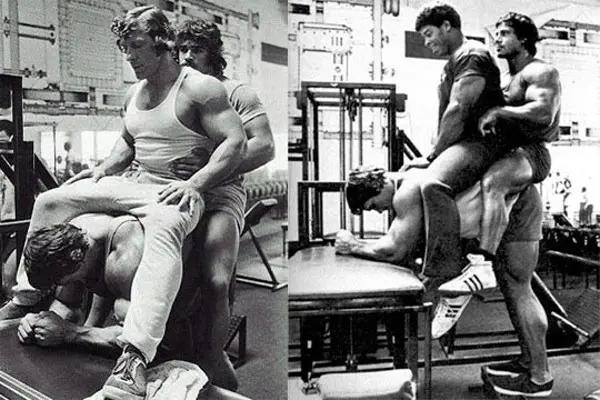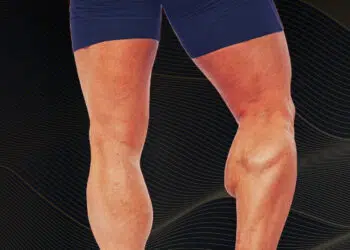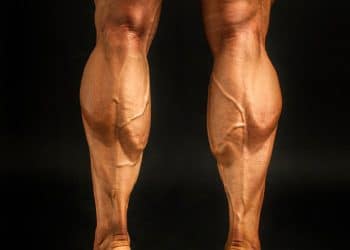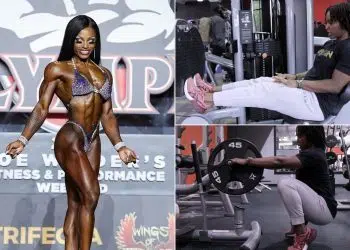The calf muscles are quite possibly the most stubborn when it comes to getting them to respond to the training stimulus. And a lot of calf growth potential depends on genetics but that doesn’t mean you can’t get them to grow a little bigger and maximize what your momma and daddy gave you.
Now, most people are familiar with the seated calf raise machine and other common pieces of equipment used for calf training in most gyms. But, we could all probably agree that these movements get monotonous after a while.
So, sometimes it’s good to introduce new exercises, especially for emphasizing certain parts of a muscle to hit different fibers, and to maximize tension and metabolic stress; which are essential for stimulating new growth! (1)
So, we searched for different calf exercises which most people probably don’t do and that are also effective for stimulating these stubborn things…
Anatomy Of The Calf Muscles
To get the most out of your calf training, it’s a good idea to learn how these lower leg muscles attach and function.
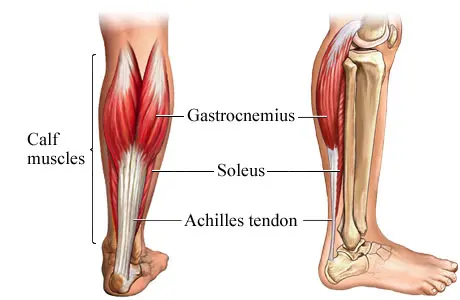
Now, there are actually two muscles that make up the calf which is the gastrocnemius, and the soleus.
Level Up Your Fitness: Join our 💪 strong community in Fitness Volt Newsletter. Get daily inspiration, expert-backed workouts, nutrition tips, the latest in strength sports, and the support you need to reach your goals. Subscribe for free!
The gastrocnemius is actually the large, visible muscle which most people think of as the “calf muscle,” and It has two heads which you can see shorten and lengthen when you lift your heel off of the ground.
Then you have the soleus which is longer and flatter, located underneath the gastrocnemius.
Both muscles are attached to the Achilles tendon; which is attached to the heel. So during movements which require the leg muscles; the calves lift the heels up off the ground. (2)
The gastrocnemius actually crosses the ankle and knee joint so it can actually flex the knee as well. While the soleus crosses the ankle. But the calves are also involved in plantarflexion so they’re activated during movements like the squat for instance (although to a smaller degree).
But what many don’t know about the two calf muscles is that the soleus is more dominant for standing postural support since 80% of the muscle tissue is composed of “type I” slow-twitch fibers.
The gastrocnemius consists of about 55% slow-twitch fibers and the rest are “type II” fast-twitch fibers; but it’s better structured for multispeed locomotion than the soleus. (3)
Check out our “11 most effective calf raise exercises” article for even more great options.
Try These Unique Calf Exercises
Always warm up with a few progressively heavier sets starting with your body weight to develop a mind/muscle connection and prepare your ankle joints for the movement with added resistance.
You never want to do a full range of motion calf exercise without warming up and you’ll know what we mean later on after the workout when you feel the joint discomfort.
1. Cable Standing Single-Leg Calf Raise W/ Elevated Forefoot
You might be thinking… “what the heck is this”? Well, let us explain.
Cables are an amazing piece of equipment because they provide constant tension to the target muscle. And because we previously explained that tension is an essential aspect of muscle hypertrophy (based on science), it only made sense to include a cable exercise.
Now, since this exercise involves training each calf individually, you also get the unilateral benefits. Unilateral calf training is beneficial for preventing muscle imbalance, improving balance and core stability, isolating a muscle, and even facilitating rehabilitation. (4)
To perform this exercise…
- Attach a single-grip handle at the lowest point of the cable machine.
- Place a stable elevated surface like a couple of weight plates for each foot in front of the cable pulley. The elevated object should be high enough to where you can get a full range of motion through the ankle joint.
- Place the top half (forefoot) of your left foot on the plate pointing straight forward. Then pick the cable up into a standing position with your left hand while holding onto the cable system with your right hand for balance.
- Tighten your quads and lower your heel down just before it touches the floor and then lift it as high as you can, flexing your calf muscles.
After you’ve completed one set, switch feet and repeat. Try to get 12-15 reps to failure with a challenging weight and do 3-4 sets. Make sure to perform the exercise using a full range of motion and try different foot positions to emphasize a different head/muscle.
Here’s a video example without the elevated surface…
2. Single-Leg Doorstep Calf Raise
All you need for this exercise is… you guessed it, a doorstep.
These are excellent when you can’t get to the gym and you can get a serious workout in with only your body weight (but you can also add weight if you so choose).
To perform this exercise…
- Place the front of your foot of choice on a doorstep so that your heel is hanging off and hold the door frame with one or both hands for balance.
- Keep your legs straight and tighten your quad.
- Lower your heel as far as it will go with a slow, controlled movement to prevent tendon damage.
- Then perform the positive portion of the movement by lifting your heel up while contracting your calf muscle and hold it for 2 seconds.
- Perform a slow negative and repeat.
- Then after you’ve completed set switch legs.
Do 4 sets of AMRAP (as many reps as possible) to failure. If you’re using a full range of motion you shouldn’t be able to do endless reps. Switch up the positioning of your feet every now and then to emphasize different fibers.
For a more advanced version of this exercise, hold weight with the same side hand and perform the exercise as normal.
3. Smith Machine Donkey Calf Raise
You may remember seeing Arnold Schwarzenegger performing this exercise with two women sitting on his back in the movie “Pumping Iron” from the 70s. And it was definitely common for people back then to do calf exercise.
But nowadays, we have so many equipment that is designed to mimic every type of movement, so the donkey calf raise is seldom seen today in most gyms. However, it’s still an effective movement and the great news is you don’t need a partner to sit on your back, thanks to the Smith machine!
To perform this exercise…
- Stack plates under the Smith machine so that when your feet are set, the Smith machine bar sits on your lower back.
- Place a bench in front of you to rest your elbows on during the movement.
- Place your feet straight forward on the plates and lean on the bench then lift your butt up so your back lifts up the bar. Keep your legs completely straight.
- Perform the 90-degree bent calf raise by using a full range of motion.
Do 3-4 sets using a lighter weight for 15-20 reps. You can use a foam pad for comfort and feel free to add weight… within your capabilities.
Here’s a video example of the Smith machine donkey calf raise…
4. Standing Calf Jumps Using A Machine
This explosive calf raise exercise is amazing for taking advantage of the fast-twitch fibers in the gastrocnemius. So, during this movement, you’ll explode upward into the concentric contraction phase where the calf is in a flexed position.
And this also takes advantage of the natural strength curve of the calf muscles.
To perform this exercise…
Level Up Your Fitness: Join our 💪 strong community in Fitness Volt Newsletter. Get daily inspiration, expert-backed workouts, nutrition tips, the latest in strength sports, and the support you need to reach your goals. Subscribe for free!
- Position yourself on a standing calf raise machine or Smith machine (with plates to elevate the feet) so that your knees are in a bent position to where you can explode upward; with your feet pointing forward.
- Keeping your torso straight, explode upward using your quads until you can flex the calf muscle at the top simultaneously.
- Slowly lower your heel back down for two seconds and get a good stretch.
- Then repeat.
Do 3-4 sets of 12 reps. Make sure to use your quads to lift you up into the top portion of the calf raise so that you can effectively contract the muscle at the top in an explosive manner.
Check out this video example…
5. Plie Squat Calf Raise
The plie squat calf raise is… well, “different,” and you don’t often see anyone doing this variation. Now, you can use your body weight and/or you can hold some dumbbells to add more resistance.
But it’s a bent-knee variation which should be performed using a higher rep range to really work the soleus (we’ll explain the reasoning shortly).
To perform this exercise…
- Spread your feet out wider than hip-width and point your feet outward. A wide stance is important for full range of motion during the exercise.
- Squat down until your upper legs are parallel to the floor keeping your back and head straight.
- Lift your heels and squeeze your calves at the top for 2 seconds.
- Slowly lower your feet back down and repeat.
Do 3-4 sets. Make sure your feet are wide enough to where you can feel a full stretch on the negatives. You can hold your arms out in front of you or place them on your hips. You can even place your knees out in front of you rather than to the side for an alternative.
If you choose to use more weight in the form of dumbbells or a barbell on your back, make it a priority to keep your back straight and head forward. With these types of movements, it’s too easy to lean forward into the movement but this is dangerous for your upper extremities.
Here are a few video examples…
6. Seated Single or Double Bent Leg Calf Raise (No Machine)
The seated bent leg calf raise is another exercise which targets the soleus due to the bent knee position. It’s a great alternative to the seated machine calf raise and you can even do it at home with some dumbbells, a barbell, or any weight that you can use. And a Smith machine setup is also another option.
For this exercise, you just need a bench or any seat and a small, elevated surface for your feet, to get a full range of motion.
To perform this exercise…
- Place a weight plate or similar item on the floor for your feet.
- Sit on the bench, place your foot/feet on the object so that your heel is hanging off and hold the weight on your lower thigh near your knee. If you’re training both legs, place the weight on or across each leg.
- Perform the calf raise slowly up and down.
- Switch legs and repeat if training one leg at a time.
Do 3-4 sets of this exercise using mostly higher rep ranges. Keep your knee slightly more bent than 90 degrees to ensure you get a good calf stretch.
Here’s a video example…
Important Training Tips
- For standing calf raise exercises, keep your quads flexed which straightens the leg, therefore keeping the focus on the target, and it prevents you from using the quads to cheat your reps.
- For seated, avoid pulling the weight upward using the machine grips. Instead, hold onto each side of the seat and lean slightly backward which will prevent the temptation to cheat.
- It’s very important to use a slow and controlled movement with each exercise to avoid allowing the Achilles tendon to take over during the first portion of any calf raise variation.
- Feel free to experiment with different foot positions for an additional stimulus of certain muscle fibers, but stick with a neutral foot position majority of the time.
- Do both heavy and lighter training to stimulate both fibers, and mix up the rep ranges for the same reason.
- Avoid training too heavy. You don’t want to go below 6 reps because you’ll be putting your joints and tendons in a position they don’t need to be in.
Benefits Of Calf Training
Besides developing stronger and bigger calf muscles, high-speed calf training actually improves the rapid force-generating capability of plantar flexion according to one study conducted on elderly men over the course of eight weeks. (5)
But the many obvious benefits of calf training has to do with function. For example, strong calves are beneficial for walking, running, jumping, climbing stairs and overall lower leg function where optimal plantarflexion is necessary. (6)
But increased stability is another benefit which is an important aspect of structural health.
“From a functional standpoint, it’s important that anyone who does resistance training incorporate a variety of muscle groups, but especially in the lower extremities because leg and ankle strength are so important for balance and the prevention of falls,” explained Chhanda Dutta, a scientist with the National Institute on Aging.
So as you can see, calf training goes beyond just the aesthetic and performance benefits.
What’s The Best Way To Train Calves?
Since we’ve already established that the soleus contains more slow-twitch fibers and the gastrocnemius is more conducive to locomotion, it makes sense to train them accordingly. And outcome specific programming is the way to go here. (3)
Now, because the gastrocnemius has a decent amount of explosive, fast-twitch fibers (although it still types I fiber dominant) it makes sense to do more standing calf raise exercises with more explosive and heavier resistance loads to maximize these type II fibers.
But you should also do higher rep movements to maximize the slow twitch fibers of the gastrocnemius as well.
And a few notable benefits of doing standing exercises are improved neuromuscular coordination and overall better physical performance/movement so this should be a variation you use often.
Since the soleus has more type 1 endurance fibers than the gastrocnemius, more higher rep, lighter to moderate resistance training is a no brainer. And bent-knee/seated calf raise variations are better for training the soleus since they isolate the muscle most effectively. So, the soleus responds better to this type of training rather than heavier, more explosive movements.
But that doesn’t mean the soleus won’t benefit from more explosive training because it still has some fast twitch fibers.
Now, regarding the aspect of foot position and training the calves with different angles; One study found that using an external (foot pointing outward) foot position showed significantly greater activation of the medial (inner head) gastrocnemius. (7)
But an internally rotated foot position resulted in significantly greater activation of the lateral (outer head) gastrocnemius.
And this is why using a combination of both standing and bent-knee/seated calf raise exercises with different foot positions is best for training calf muscles to their fullest potential.
Final Thoughts
Try these different Calf raise exercises to mix up your training a little. You may or may not see a significant difference from your current calf training routine but at least you won’t suffer from boredom, and you can look forward to calf training.
We’ve provided some scientific-backed information to best optimize your results but at the end of the day, everyone’s outcomes will vary. And a harsh truth is that calf growth and shape is mostly genetic.
So although you may hope for your calves to take on a certain shape or size, you can only develop them to an extent. And this is similar to many body parts, so we’re not just picking on the calves.
But your job is to always put in the hard work and give your absolute best, regardless of any genetic shortcomings!

